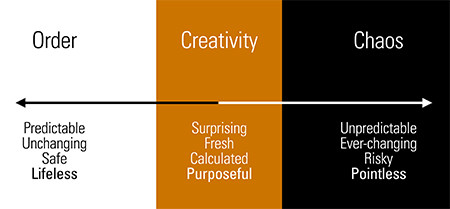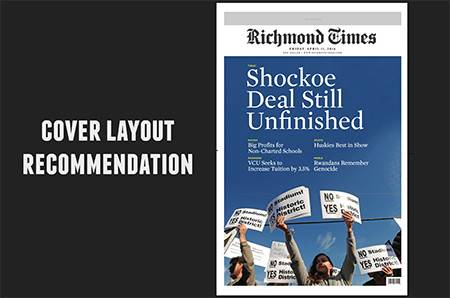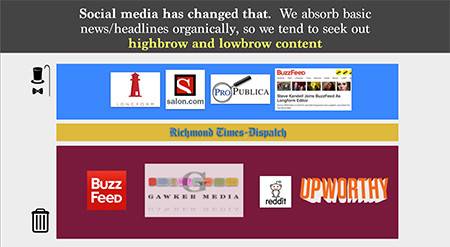From ideas to execution

The key to success for the future in newspapers is to embrace creative, educated, calculated changes before "the other guys" cannibalize our market share, Professor Kelly O'Keefe of Virginia Commonwealth University told publishers at SNPA's News Industry Summit.
O'Keefe has been a marketing innovator for more 20 years. Prior to becoming a professor and managing director of the VCU Brandcenter, he led O'Keefe Marketing, a pioneer in digital marketing and branding.
During the Tuesday morning General Session in Charlottesville, Va., O'Keefe talked about the power of creative thinking and shared four prototypes for reinvention of the Richmond Times-Dispatch that one of his graduating classes at VCU put together for Publisher Tom Silvestri.
In introducing O'Keefe, Silvestri said the students' work "really launched us into a deep reflection on what our brand is." The project examined what's burgeoning in the digital area and translated that onto print.
O'Keefe said most people tend to think about branding in terms of advertising slogans, but that's not the most significant part of the brand equation. Brands, he said, are built much more on what we're doing than on what we say.
He said the newspaper industry is in need of a good dose of creative thinking, which he described as a way of looking at problems or situations from a fresh perspective that suggests unorthodox solutions.
And, he said that – in some ways – the industry is already known for this: "taking the alternative viewpoint on issues, challenging the status quo, being willing to dig deeper and question."
He stressed the need for newspapers to create an environment where they cannibalize their own products instead of waiting for the competition to do it. "We can't wait for the other guys to cannibalize our market share," he said, "to take things away from us – like Craigslist did. We have to be the ones that make the change before they get to it." During difficult economic times, creativity becomes increasingly important, he said.
Creativity isn't about doing something wild and outrageous, and it's not change for the sake of change. He described a continuous spectrum with chaos on one side (total insane creativity) and order (with an absolute lack of creativity) on the other. "Great creativity is in between ... it's at the center of this spectrum," he said. "Great creativity is taking risks that are calculated ... and purposeful."
He challenged newspaper publishers to consider whether their papers have changed enough. "Have we taken enough calculated risks to improve the quality of our product, to improve the receptivity to younger audiences who we must count on if we intend to stay in business for a long period of time?"
To drive creativity, he encouraged newspapers to be a little bit fanatical. He cited Apple as one of the most creative companies in the world, while also noting that it has very slow product development cycles – the slowest in their industry. He said the key to creative thinking is "doing things differently, but doing them with incredible refinement." He said, "It's about doing a few things exceptionally well."
The newspaper reinvention assignment that he gave his students challenged them to use the Richmond Times-Dispatch and find an innovative and viable approach for bringing new life to the newspaper industry.
Their assignment:
- Reinvent the newspaper experience to increase relevance for both existing readers and targeted young readers.
- Consider the interaction between print and digital componets, but the print edition must continue and be enhanced by their work.
- Review all available audience research and suppplement it with their own research into the mindset of current and targeted readers.
- Review the arguments made for the value of newspapers in books like "The Assault on Reason" by Al Gore and blogs like InnovationsInNewspapers.com.
- Present a clear, focused strategy with specific layout recommendations for the front section and other sections of the newspaper.
One of the four teams looked at Millennials and found an opportunity they were not expecting: the culture of SLOW.
"In an era when we think of Millennials as having a short attention span, they are actually doing some things that reflect the opposite," O'Keefe said. He said the students found that 72 percent of Millennials prefer long, narrative TV series, and many are taking the time to prepare their own food (instead of eating out) and are going back to vinyl records. Research also showed that 97 percent of Millennials say they find it more enjoyable to go and buy a gift in an independent shop than in a big department store.
He said this culture of slow "is moving from convenience ... and newspapers can play along with that." Knowing that Millennials already get their convenient news somewhere else, he challenged newspapers to become a luxury for them. "Acknowledge that they get quick bits of information through other sources," he said, and give them detailed information from a more luxury source with quality, in-depth, rich content in longer form and allowing for greater time investment.
He said the notion of luxury newspapers is an "interesting one" and encouraged newspapers to position the physical newspaper as an indulgent experience.
Among the comments he said students cited from Millennials:
- "There's something about longer-form news that I prefer; it's talking about things I already know, but it has greater impact, greater depth. I'm learning way more in a 5,000-word essay."
- "I really enjoy the ritual of reading the newspaper. I sit opposite my husband, we share sections, have our cappuccinos and discuss. It's wonderful. I feel informed and smart."
The content strategy that this team proposed includes:
- Long-form content that averages 3,000 words.
- In-depth, more investigative journalism.
- More pointed writing that inspires debate.
- True journalism featuring many points of view, including readers'.
- The use of white space to help tailor the reading experience.
This team also was inspired by the cover layouts of popular magazines and recommended simplifying the cover of the Richmond paper to make it more like a magazine cover, with more in-depth story-telling inside.
 |
He also noted that the students suggested changing the name of the paper, dropping the word "Dispatch" because they said no one knows what that means.
Another team presented a proposal that the newspaper become much faster to read, and another suggested a little of both – finding that readers are interested in all types of news, ranging from "lowbrow" to "highbrow."
O'Keefe defined "highbrow" as meaty, in-depth analysis pieces that help people feel smart.
"Lowbrow" items are those guilty pleasures that get discussed around the water cooler.
The interest in middle ground content (the category that most newspapers fall into) is shrinking, this team concluded.
 |
O'Keefe said consumer trends are going to heavy use of long form and short form. "The most shared stories on social media are either very short snappy or topicial ... or very long analysis pieces," he said. "The data actually supports the fact that we need to give them the full range of the spectrum – give them something that's really quick and give them stuff that's long ... and not worry as much about the middle." In addition, he said newspapers should add in personality or point of view items with a local focus. Offering the local connection – even in national stories – will draw a higher degree of interest, he said.
This team also suggested that newspapers move from a traditional layout to a digitally-inspired layout – from a print mindset to a social mindset.
 |
"It's not about which one of these is right," O'Keefe said. Instead, he said the key to success is acknowledging that doing nothing is wrong. "There are multiple right answers," he said. What's important, he said, is making "educated guesses" and not letting a "remarkable industry" slide.






